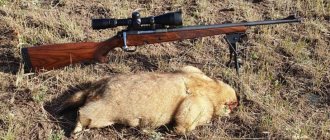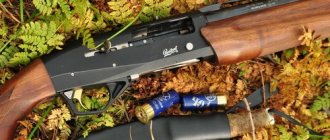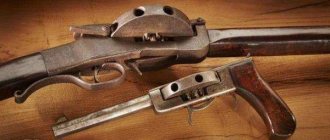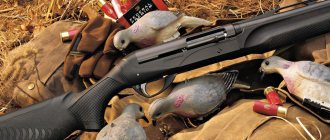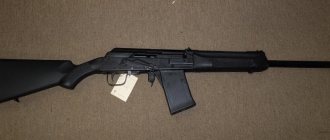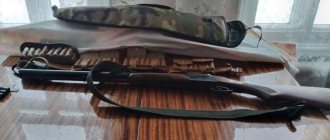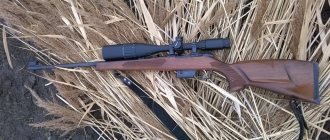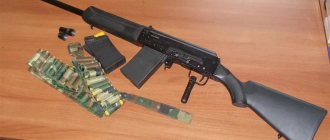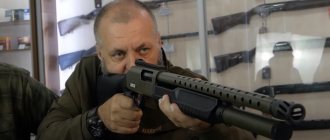Pros of an old gun
When faced with the opportunity to purchase or use an old gun, a person compares it with new products. Experience shows that a brand new copy is not always better than its counterpart with half a century of history. The fact is that with careful use, proper storage and proper care, the life of an old hunting rifle is extended.
There is another important factor that directly affects the quality of the manufactured barrel. Today's guns are mass-produced on machines, without the manual labor of specialists. This product has no soul. Old hunting rifles, even mass-produced in the first half of the twentieth century, have a quality that is an order of magnitude higher than modern analogues, akin to piece production in today's realities.
That is why avid hunters try to purchase a gun, the year of manufacture of which dates back to the first half of the twentieth century (and perhaps to the end of the nineteenth). They believe: despite all the effectiveness of modern technology, it cannot replace the professionalism of gunsmiths.
Old guns are divided into types according to visible criteria. Let's look at some of them: with folding and non-folding trunks; with one or two barrels; with and without triggers.
Review of the rare and unique IZH-K
After the Second World War, when life in the USSR began to return to normal, there was a need for hunting smoothbore guns for the mass consumer. Moreover, the gun had to be simple, reliable and of high quality. Izhevsk gunsmiths coped with the task remarkably well: in 1954. year, a new, lightweight, unpretentious and trouble-free smoothbore hunting shotgun IZH-K appeared, followed by several modifications of this shotgun of various calibers and in different designs from ordinary to one-piece. In total, about 58 thousand copies of this single-barreled hunting rifle were produced. In 1964. year, the production of IZH-K was completely stopped, as it was replaced by a more modern model IZH-18.
Popular single-barreled guns
The end of the nineteenth and beginning of the twentieth centuries is characterized by the fact that many converted weapons ended up in the hands of hunters. People called them "berdans". These were smoothbore shotguns with a non-retractable barrel. They remade army rifles like “Berdan-2” or three-line Mosin. The best modifications were produced by the Izhevsk and Tula factories. The Berdan-2 rifles produced single-shot shotguns of 16, 20, 24 or 28 calibers. The length of the trunk varied from 68 to 69 cm, the weight remained from 2.6 to 2.9 kg.
From the Mosin rifle, the designer Frolov managed to create single-shot guns of 20 and 24 calibers and magazine guns of 28 (for two cartridges) and 32 (for three cartridges) calibers. “Frolovka” was slightly heavier than Berdana (minimum 2.8 kg, maximum 3 kg). After the war, they began producing the R-32, a single-shot 32-caliber model. By 1948, their production was suspended. Such hunting rifles turned out to be cheap, but their characteristics were not very high. Therefore, they were quickly replaced by new models.
Single-barrel old hunting shotguns with a folding barrel can be hammered or hammerless. In the 20s of the twentieth century, the IZH-5 model with an upper unlocking lever was put into mass production. It was manufactured by both Izhevsk and Tula factories. The calibers of the produced single-barreled gun are 12, 16, 20, 24 and 28.
After the war, the Izhevsk plant began producing single-barrel guns of 16, 20, 28 and 32 calibers with a lower unlocking lever (ZK, IZHK). The next model, IZH-17, was produced in large quantities and remains in the service of fishermen to this day.
Hammerless single-barreled guns were produced in our country only after the war. These are the ZKB and IZHB models. In the early sixties, the IZH-18 was designed on their basis. In various modifications, such a gun is still produced in Ustinov at the Mechanical Plant. From the experience of skilled hunters, it can be argued that old single-barreled shotguns are in many ways superior to their modern counterparts.
Old combination guns
Combination shotguns with flip-up barrels are not currently mass-produced. Only TOZ-34-5.6 is produced in small batches, as already mentioned. Previously, two models were mass-produced. In 1957-1958 The Zlatoust Machine-Building Plant (in subsequent years the production of hunting weapons there ceased) produced the “Deer” hunting rifle with a vertical barrel arrangement connected by couplings. The weight of the gun is 2.5-2.75 kg, the length of the barrels is 675 mm. The upper barrel is smooth, 32 caliber; The lower barrel was made in two versions - 32 caliber with a paradox rifle and a 12.5 mm rifled barrel.
The “Olenya” variant with a barrel equipped with a “paradox” muzzle device is legally a smoothbore weapon; a variant of a gun with a barrel with rifling of more than 140 mm in barrel length is legally a rifled weapon, and special police permission is required for its acquisition and use. The locking lever for the Deer is located at the bottom of the box. External trigger, one for both barrels; the trigger is also the same. To switch the trigger from one barrel to another, you need to move the button located behind the trigger. Another model of combined weapon is the IZH-56 “Belka”.
This hunting rifle was produced in large series from 1956 until the mid-1960s. The designers created three modifications of this gun, of which the third variety, IZH-56-3 “Belka,” was produced in the largest quantity. IZH-56-3 "Belka" has barrels located vertically and connected by a coupling. The weight of the gun is about 3 kg, the length of the barrels is 650 mm. The lower barrel is smooth, 28 gauge; top rifled, 5.6 mm caliber chambered for rimfire cartridge. Lower release lever; one hammer, one trigger; switching, like the "Deer".
A 2.5X optical sight was installed on the gun on a removable bracket. The stock is straight, the forend is removable. For many years, the Belka was the main gun in the small fur game industry.
Common double-barreled shotguns
Despite the delights of single-barreled guns, old double-barreled guns have become very popular. Their production, which began at the dawn of the twentieth century, continued until the eighties. First they produced model B guns, then from the late fifties - BM. The gauge of the vast majority was 16, a little 20 and even less than 12. Models TOZ-63 produced 16 and 20 calibers, TOZ-66 – 12, TOZ-54 – mainly 12 calibers. Such a weapon is suitable for both shot and buckshot, and bullets. Fishermen and hobbyists note its suitability for any type of hunting, ease of operation, and reliability.
Tula-made hammer-fired double-barreled guns have varied muzzle devices. Usually the right barrel is a cylinder with pressure, cylinder, pay; the left barrel is a choke or payload. The length of the barrels is 70-72 cm. The barrels are locked with a Greener bolt and two lower hooks. The rifle's overhead lock has external hammers and two triggers. The trigger and impact mechanisms are mounted on locking boards. The hammers have a safety cock; when they are manually cocked, the mainsprings are pumped. Usually the stock of a gun was made of birch or beech, sometimes of walnut. The weight of the gun is about three kilograms.
The Izhevsk plant produced hammerless double-barreled shotguns with folding barrels. For ten years (1936-1946), the IZHB-36 model was produced in large quantities with locks on the side boards. The modified IZHB-36M series was produced only in 1947. These are products with triple locking, automatic safety, detachable forend, 12 gauge. Old guns are convenient and durable to use.
After the transfer of the monopoly on the production of hunting rifles to the Izhevsk Mechanical Plant, the IZH-49 model was put into mass production. This is a double-barreled shotgun of 12 or 16 calibers (20 caliber was produced in a small batch).
The characteristics of the product were changed in 1954, when, taking into account the recommendations of hunters, a modified model IZH-54 was released. The common 12 gauge had a barrel length of 750 mm (later - 730 mm). The length of the chambers is seven centimeters. The muzzle constrictions have a parabolic shape: in the right barrel - a gain of 0.5 plus or minus 0.05 mm; in the left barrel - a full choke of 1.0 plus or minus 0.05 mm. Release lever on top. Triple locking shotgun. The trigger mechanism is installed on a separate base. The firing pins and triggers are mounted in fire tubes. When the gun is opened, the hammers are cocked. After the hammer hits the firing pin, it returns to the release position, releasing the firing pin. The safety automatically locks the triggers and sears. This prevents the gun from accidentally firing. Forend with a lever-type latch, detachable. The weight of the gun is 3.2-3.6 kg. The design can withstand 7,500 shots without consequences.
The IZH-54 model became the first serial hammerless double-barreled shotgun in the USSR. This old hammer gun is reliable and has become incredibly popular among hunters.
The double-barreled shotgun without triggers, created in Tula, did not gain such popularity. The Tula arms factory became famous for its guns with vertical barrels. The Tula vertical MTs6 and the Izhevsk Izh-12 had many common features. Fishermen loved such guns. With them you can hunt both waterfowl and small animals (hare, fox). They are reliable in hunting predators (wolves, bears) and ungulates. The lower barrel is perfect for using bullets. Now they are producing the IZH-27 model, which is a modification of the IZH-12.
Today, old IZH guns continue to be extremely popular. The model IZH-56 (modifications 1, 2, 3) “Belka” is of special importance. This model's single external trigger works on both barrels. To switch from one barrel to another, just press the button located on the shank of the block. The latest modification was distinguished by the fact that above the smooth barrel there was a rifled barrel chambered for 5 and 6 mm caliber cartridges.
Most of the models described have long been discontinued. But you can often see hunters using old guns. You can see photos of similar specimens in the article. Such guns don’t just sit in the safe, but perform their function flawlessly.
Technical characteristics of TOZ-66
The TOZ-66 double-barreled shotgun had the following technical characteristics:
- The block of Tula hammer barrels had a length from 700 to 725 mm. The most common modifications were those with a barrel length of 720 mm;
- The weight of the weapon depended on the length of the barrel and varied from 3.1 to 3.75 kg. This parameter could be influenced by the type of wood that was used to make the stock;
- There were several types of lodges. They differed in the shape of the neck, which could be straight, semi-pistol or pistol. In most cases, the manufacturer installed a universal stock with a semi-pistol neck, which was suitable for the vast majority of hunters;
- The diameters of the barrels often did not correspond to the passport data, and could differ by not a tenth of a millimeter, so the owners measured the diameter with a caliper in order to avoid problems when shooting bullets.
There was also an extremely rare shortened version, which had a barrel block only 510 mm long. Apart from the length, this modification was no different from the standard one.
Old hunting pneumatic
One of the trends in hunting barrels is old air guns. Air rifles produced by the Izhevsk Mechanical Plant have become a global brand. Customers from all CIS countries treat this type of weapon with great respect and gratitude. Many made their first shot with an air rifle. It is easy to control, reliable in aiming and durable in use. The Izhevsk rifle is ideal for shooting training and is indispensable for hunting.
Depending on the caliber, you can count on a certain amount of prey. So, with a 4.5 mm caliber you can count on a duck or blackbird if it hits the body, and a goose, pheasant, black grouse or hare if it hits the head. A novice hunter can hit game from a distance of no more than sixty meters (although everything here is individual).
The laws of the Russian Federation impose restrictions on hunting air rifles. These include: muzzle energy no more than 25 J; the owner's age is at least 18 years (allowed from 16 years in the Tyumen and Tomsk regions); registration within two weeks; prohibition to install silencers. It is important to remember that older air guns lose accuracy as the caliber increases, but increase stopping power. At the same time, the barrel becomes heavier and wears out faster.
Advantages and disadvantages
The IZH-17 hunting weapon helps to perform many tasks at the request of the hunter. The thick-walled barrel promotes accuracy when shooting bullets. The gun is simply ideal for shotgun shooting at 45 m. The weapon is comfortable, agile, lightweight, with excellent balancing. The return is very small. In addition, a single shot disciplines.
The advantages of IZH-17 include:
- Variety of calibers 12-32;
- Simple design;
- Simple and quick repair;
- Good ergonomics;
- Unconditional reliability;
- Quick adaptation to operation.
Nowadays, some hunters are experimenting with the IZH 17 with a variety of cartridge loads, and it can withstand even terrible experiments, which indicates the high-quality performance of the model.
The disadvantages include the following:
- Difficulty in purchasing today.
- Worn-out models make a lot of misfires.
- The IZH-17 single-barreled gun is an excellent option for a beginner, but only in decent condition.
- Hunters have noted the fact that it is better to shoot with black powder, but the center shot is weaker with smokeless powder.
Features of choice
If a person decides to purchase an old hunting rifle, he must clearly understand why he is making the purchase. It's one thing to hang it on the wall and admire your collection. To do this, just carefully examine the old guns. A photo of their appearance will also be enough. And it’s quite another thing to use it for its intended purpose. Although old guns are legendary, the buyer should be concerned about his own safety and carefully inspect the item he is purchasing.
Inspection of the gun should begin from the forehead of the block. Gases escaping from the primer during a shot hit the metal in the block and lead to its corrosion. This is observed in the resulting burnout ring and in cavities near the striker. These same gases thin the firing pin. When using a gun with such defects, it is possible that gases will escape backwards, which can lead to its damage (for example, to a breakthrough of the stock at the junction with the block) or injury to the shooter.
The next factor: the critical looseness of the barrels in the block. It can be determined by the presence of gaps between the block and the barrels. With sufficient wear, the shock load increases, which leads to the appearance of gaps in the locking units. As a result, transverse play of the trunks is observed. The number of gaps created can cause the gun to open up or cause the barrels to burst. This puts the person at risk of serious injury.
The most dangerous is a breakdown of the locking device or the valve spring sediment. The reliability of fixing the locking plate depends on the force of the spring. The absence of a reliable lock increases the risk of spontaneous opening of the gun. The ejection of the cartridge case, the release of gases, and the rupture of the muzzle cause the possibility of causing harm to the shooting hunter.
Barrel defects
When using a gun for a long time, metal fatigue occurs. This is the result of vibration and stretching of the barrels, shock loads and torques. “Sinks” are considered the most destructive to the trunk. In the USSR, they refused to register a gun if 15% of the surface of the entire barrel area was covered with them. The location of the “shells” also matters. They are especially dangerous in the projectile entrance and behind the chamber (the so-called peak pressure zones). Minor rash or lead coating does not affect the strength of the barrels or the combat of the gun.
Damage to the gun barrel in the form of dents is also dangerous. The metal can reach its toughness limit and collapse during a shot. You should also pay attention to a gun with a coupling connection. This is when the barrel and chamber are made separately and then soldered together. A gap may appear where the chamber and barrel meet. This is dangerous because the shot can turn the chamber around.
The trigger mechanism also deserves attention. Malfunctions of the trigger most often lead to the triggers being de-cocked. The gun may fire if shaken or dropped. The reason for this problem is wear of the trigger and sear engagement protrusions, breakage of the sear spring, wear of the trigger and sear landing axes. A faulty safety should be a mandatory reason for refusing to use this gun for its intended purpose.
About the design
The gun is represented by the following elements:
- Two detachable trunks located horizontally. For this reason, TOZ-63 shotguns are also called “horizontal guns”.
- High-quality chrome-plated barrel channels with different choke constrictions, which had a positive effect on the accuracy of fire.
- Mainsprings, which are cocked by combat hammers. Judging by the reviews of the owners, the double-barreled shotgun can be put into combat readiness in a couple of seconds.
- Ejector. It is common to two trunks. Responsible for the extraction of spent cartridges.
- A removable forend, which is fixed with a lever latch.
Mostly stocks are made of birch. For improved modifications, the manufacturer can use beech or walnut.
Stock defects
Some amateurs continue to hunt with stocks wrapped in wire or duct tape, or even just with chopped stocks. In addition to minor injury from rebounding wood chips, you can also receive more serious damage due to an arbitrary or double shot. Reason: the wooden part slightly lifts the ankles of the sear or the lock “walks” in the stock.
Of course, you can try to eliminate all the described shortcomings. But for this you need to find a master, and this is not easy in modern conditions.
Registration and deregistration
The purchase of an old hunting rifle leads to the need to register it. When asked how to register an old gun without documents, you can get conflicting answers. They all come down to the complexity of carrying out such a process. In theory it looks simple. The first step is to write the correct explanatory note addressed to the head of the Licensing and Permitting Department (OLRR). It must indicate the origin of the gun without documents (got it from my grandfather, found it in a barn, and so on). Be sure to indicate that you would not like to scrap the barrel, but register it in your name. The gun must be inspected, the numbers written down and a request made to the information center. Shooting is carried out in a bullet casing. If the result is positive, we receive a certificate and register it. All.
Realities may lead to a different path, slow, with obstacles and delays. In this case, if you receive a refusal at the first stage, all other steps should be taken after going to court and receiving its decision.
Things are simpler with registering an old gun with documents. You need to submit papers for the barrel, confirm your ownership (inheritance, purchase, donation) to it and a package of documents in your name about permission to purchase, store and carry weapons.
The answer to the question of whether it is possible to register an old gun is extremely simple. Yes, you can. Just be prepared to waste time, money and nerves. In some cases, registration can take six months, sometimes it will take several years.
But deregistering an old gun is much easier. To do this, you should contact the police with a statement about the voluntary surrender of the barrel. The weapon is inspected, the number is recorded (if there is none, then a temporary one is assigned according to the serial registration number) and they give you a receipt (one copy is attached to the barrel).
Price for IZH-17
Finding a decent IZH-17 in acceptable condition on the modern market will not be an easy task, despite the huge number of barrels produced in the 60s and 70s. But nevertheless, worthwhile examples periodically pop up on thematic websites about the sale of weapons, which the potential future owner will have to regularly monitor.
The average cost of an IZH-17 at current prices for 2022 in satisfactory (working) condition is only 10,000 rubles, and this price is even higher than the average. We can definitely say that the IZH-17 is worth the money and if it is put in order, it will last for many more years.
Necessary care accessories
Properly organized storage of a barrel can prolong its combat qualities for many years. Lack of maintenance or inappropriate maintenance can ruin even the most wonderful gun. It is undeniable that the gun must be stored in a special safe so that no one else can take it, use it or damage it. The place for the safe must be dry, because dampness is the main enemy of iron. The gun must be transported in a special case (case).
It is necessary to regularly inspect, lubricate and clean your hunting rifle. Some supplies will be required for maintenance. This is a cleaning rod, various tips for it (puff, brush, visher), an oil can, two or three pointed wooden sticks. Carefully washed dry rags (linen or cotton, bandages) are used as cleaning materials, which are stored so that sand or other small foreign objects do not get into them.
As a result
The IZH-17 single-barreled shotgun is a versatile option for those who want to try an old-school weapon, but with minimal effort in adaptation and repair. The fact that it is very common will also allow you to find all the necessary spare parts and cartridges without much effort. The simplicity and variability that the IZH-17 offers is the benchmark for a gun in the 1960s.
Until now, shooters often choose the IZH-17 hunting rifle. Price also plays a role for a beginner: these weapons can sometimes be bought for several thousand rubles. The gun is a weapon of wide use; it is used for both amateur and commercial hunting.
Hunters love the IZH-17 for its reliability and relative lightness. You can hear from many that the gun does not fail even in bad weather conditions, it serves excellently, exceeding the warranty range several times and, due to the simplicity of the device, is easy to repair.
IZH-17 has low recoil, which is important, especially for novice hunters. In view of this, the model can be used for training, as well as for shooting on a bench, because in one training session more than a hundred shots are fired, and after a couple of dozen the recoil becomes significant for the shooter. The gun can also withstand greater cartridge power, which allows it to increase the firing range. Until now, this model remains in service among hunters and is an excellent budget option for a beginner.
Cleaning a hunting rifle
Once you have purchased all the materials, you can begin this important procedure. How to clean an old gun? Every month, the barrel, even if no one uses it, should be wiped, all its metal parts should be treated with an oiled rag. Air humidity after the lubricant has dried can lead to rust. It is better to use a lubricant that is thick and sticky, with a neutral reaction. Old smoothbore shotguns without a self-loading device can be treated with any oil.
For self-loading barrels, you should select a brand of lubricant according to the requirements specified in the description of the model. Neutral grease can be easily distinguished from alkaline grease using a brass sleeve. The darkening of brass at the site of lubrication indicates its alkaline nature. Instead of special lubricants, you can use unrefined (yellow) Vaseline, rendered lard (lamb or beef is suitable, always unsalted). The outside of the gun is well protected from moisture by beeswax (to do this, it needs to be dissolved in turpentine or gasoline).
After each shooting it is necessary to clean the barrel. To do this you will need hot soapy water. Using a clean cloth wrapped around a cleaning rod, you need to pierce the bores of the barrel. To do this, lower the ends of the barrels into the water and move the cleaning rod up and down the channel eight to ten times. Change the cloth to a metal brush and repeat the procedure. At the end of cleaning, rinse with clean water and wipe dry from the inside and outside. Treat with neutral lubricant. Soapy water works well with fresh carbon deposits, softens rust, and removes lead. Caring for old hammer-fired shotguns is much the same as caring for other types of hunting barrels.
Periodically you should pay attention to the wooden parts of the gun. Birch and beech stocks must be inspected for cracks in the varnish coating and chips. Places where metal parts are inserted should be carefully treated with natural drying oil at least occasionally. Clean the damage from paint residues, cover with stain to obtain the desired color and apply several layers of varnish. Cracks in the forend will disappear after longitudinal milling of its lower part (cut thickness is about 1.5 mm). By following these simple rules, you can ensure that even the oldest guns look like new.
General description of IZH-17
The IZH-17 shotgun with 16 gauge is the most popular version, while its predecessors: IZH-12, 15 and 16 did not find such popularity due to their technical shortcomings. If we go deeper into history, the initial model for subsequent IZ lines was the 3K Zlatoust Kazantsev model, but it is worth noting that the differences between them are actually minimal. IZH added: a rear sight on the box, improved fastening of the forend, and, on the contrary, they decided to replace the bolt with a lever latch.
The model was mass produced from 1963 to 1970, which allowed about 500 models to be released onto the market. IZH has a fairly wide range of uses: it is used for professional and amateur hunting, and the single-shot manual loading system allows the weapon to be used flexibly in different scenarios.
As for cartridges, they can be used with both paper and metal casings.
IZH-17 with 16 gauge stock is made of beech or birch, and all metal parts are chemically painted black. Regarding the planes of the box, they are located on the sides and are decorated with engraving. Such meticulous execution allows not only to make IL wear-resistant under various climatic conditions, but also to work on the design. Among other things, the IZh has good combat accuracy, high-quality design of mechanisms and parts, as well as high ergonomics: the weapon is light and handy, which allows beginners to easily master it.
Despite the fact that the design of the IZH-17 is in many ways similar to the ZK prototype, the engineers still managed to surprise their customers with some features that had not previously been seen in other guns. Here are just the most interesting points that deserve attention:
- The barrel locking mechanism is presented in the form of a folding hook and hinge. The system is made in such a way that the hunter cannot make an accidental shot with an unlocked weapon - the bump stop simply will not hit the cartridge. But what if you have to remove a whole cartridge case from the chamber? For this purpose, a special lever is provided that disables the security system.
- Chrome plating of the chamber and barrel channel. IZH-17 was the first Russian weapon to use this system. Such a coating can significantly increase the service life of the gun, as well as reduce friction. Also, thanks to this technology, the weapon no longer requires frequent maintenance, including cleaning. Although it should be noted that the chrome coating slightly increased the weight of the barrel.
- Buttstock quick release system. There are times when hunting when it is necessary to disconnect a wooden part in order to eliminate some defect in the chamber. However, most guns produced before 1943 had a problem with this: they had to be completely disassembled. IZH-17 had no such hiccups. It was enough to simply unscrew the cylindrical screw using a universal key, and the stock was quickly removed.
It should also be noted that 50A steel was used for the production of metal parts. This metal alloy not only has a high carbon content, but also undergoes a cold hardening procedure. Thanks to this, the gun is able to withstand enormous loads and also has a long service life (up to 5 years or 5000 shots).
